
Citrullus colocynthis, with many common names including colocynth, bitter apple, bitter cucumber, desert gourd, egusi, vine of Sodom, or wild gourd, is a desert viny plant native to the Mediterranean Basin and Asia, especially Turkey, and Nubia.

Ipomoea pes-caprae, also known as bayhops, bay-hops, beach morning glory or goat's foot, is a common pantropical creeping vine belonging to the family Convolvulaceae. It grows on the upper parts of beaches and endures salted air. It is one of the most common and most widely distributed salt tolerant plants and provides one of the best known examples of oceanic dispersal. Its seeds float and are unaffected by salt water.
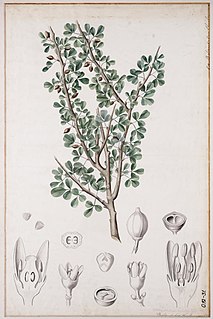
Commiphora gileadensis, the Arabian balsam tree, is a shrub species in the genus Commiphora growing in Saudi Arabia, Yemen, southern Oman, Sudan and in southeast Egypt where it may have been introduced. Other common names for the plant include balm of Gilead and Mecca myrrh, but this is due to historical confusion between several plants and the historically important expensive perfumes and drugs obtained from them.

Amaranthus graecizans, the Mediterranean amaranth or short-tepalled pigweed, is an annual species in the botanical family Amaranthaceae. It is native to Africa, southern Europe, East Asia to India and Central Asia. It is naturalized in North America. More general common names include tumbleweed and pigweed.
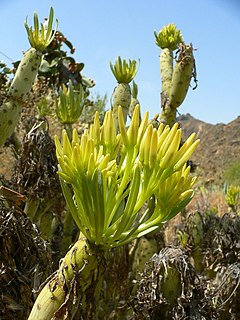
Kleinia is a genus of African flowering plants in the sunflower family. Kleinia contains around 50 species and is distributed from the Canary Islands, throughout Tropical Africa to India and Arabia. It is closely related to the genus Senecio but is distinguished primarily by having succulent stems and/or leaves.
Maytenus dhofarensis is a species of plant in the family Celastraceae and is found in Oman and Yemen. It is an intricately branched spiny shrub or small tree with its leaves arranged alternately or clustered on short shoots. The flowers have white or cream petals and the fruit are purple or red. It is threatened by habitat loss.
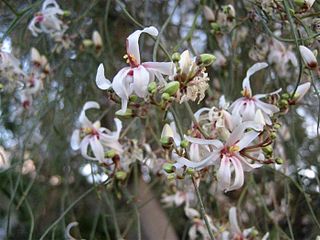
Moringa peregrina is a species of flowering plant in the family Moringaceae that is native to Arabian Peninsula Horn of Africa and Southern Sinai, Egypt and can be found throughout Arabia, Egypt and as far north as Syria. Moringa peregrina grows on rocky wadis and on cliffs in drier areas.
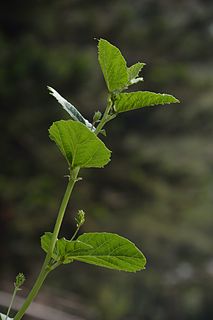
Psoralea corylifolia (Babchi) is a plant used in Indian and Chinese traditional medicine. The seeds of this plant contain a variety of coumarins, including psoralen.

Plumbago zeylanica, commonly known as Ceylon leadwort, doctorbush or wild leadwort, is a species of plumbago with a pantropical distribution. Carl Linnaeus described the paleotropical P. zeylanica and Neotropical P. scandens as separate species, but they are currently considered synonymous.
The Oman Botanic Garden is a development of the Diwan of Royal Court in Oman, growing unique plants, landscapes and covering cultural traditions of Oman. The garden is currently under construction. When it opens it will showcase all of the native plant species of Oman in a series of created, naturalistic habitats from the dry deserts to the rich monsoon cloud forests. The garden will also showcase the traditionally cultivated crops and the many ways that people use plants in Oman.

Senna italica, the Port Royal senna, Italian senna, or Senegal senna is a legume tree in the genus Senna. It is recognized by many other common names based on the regions it grows in. In India, it is used to produce a powder for treating hair-related diseases which is known as “neutral henna”. Whereas, in some parts of the world, this species is cultivated for the leaves which yield the drug senna, known commonly as Senna glycoside, which in turn is the base for a laxative. Senegal senna is easily distinguishable through its many distinctive features. There are 3 subspecies of this plant based on the size of the inflorescence and the length of the petiole. The subspecies are italica, micrantha, and arachoides. In many regions, this plant is cultivated commercially and medicinally.
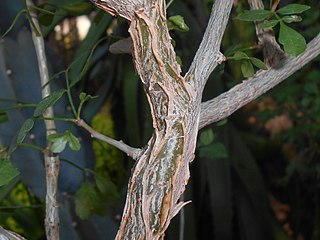
Commiphora habessinica, sometimes known as Abyssinian myrrh or the Yemen myrrh, is a plant native to northeast Africa and the Arabian peninsula, including Djibouti, Eritrea, Ethiopia, Zambia, Malawi, Oman and Yemen. It was first described by Otto Karl Berg in 1862 as Balsamodendrum habessinicum from northeast Africa. It was then transferred to the genus Commiphora by Adolf Engler in 1883, but given the name Commiphora abyssinica, an orthographical variant. It can be recognised by its simple, serrate leaves and by the pseudo aril, covering the seed, which has four almost linear arm-like lobes.
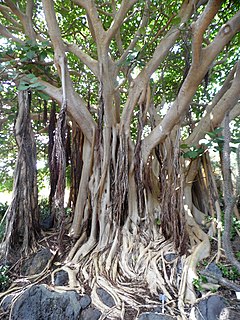
Ficus vasta is a fig plant found in Ethiopia and Yemen. The tree is a species of sycamore-fig.

Lycium shawii, desert thorn or Arabian boxthorn is a species of thorny shrub adapted to desert environments, and can be found throughout the Arabian peninsula, and some places in Africa. The thin leaved, rigid bush grows up to 3 metres high, with a lot of branches and alternating spines that vary in size, and grow along the branches and on their tips. The leaves narrow towards their base. It produces small whitish-pink or purple flowers from September until April, and red pea-sized seedy berries that are edible. Habitats include gravel plains and foothills up to 4,000 ft (1,200 m), as well as wadis. Plants often growing nearby include Acacia tortilis and Prosopis cineraria.
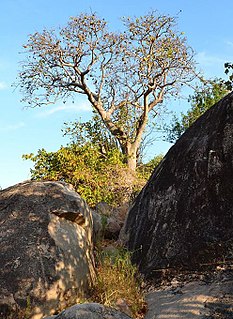
Sterculia africana is a deciduous tree, belonging to the genus Sterculia and the family Malvaceae. The species is sometimes called the "mopopaja tree". It is distributed throughout Northeast Africa to Arabia.
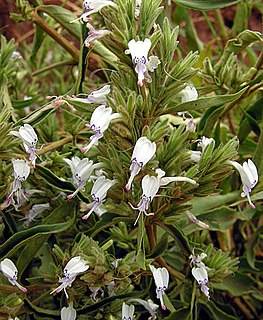
Hypoestes forskaolii is an annual or perennial herb that grows up to 1 m tall with its stem and leaves being nearly glabrous. It has pale pink or white flowers.
Pancratium maximum is a perennial glabrous herb that grows up to 30 cm tall arising from a bulb. It is endemic to south western Arabia.
Kleinia odora is found in Ethiopia, Somalia, Yemen and Saudi Arabia. It is distinguished by having succulent stems or leaves. It is common in low dry hills along coastal plains. It forms large clumps bearing dense clusters of cream or whitish flowers on the tips of the pencil-like stems.
Cyphostemma ternatum is a perennial climbing herb that grows up to 2m. It is edible and distributed throughout Northeast Africa to South Arabia. ternatum in Latin means "arranged in threes" and alludes to the arrangement of the leaves.

Remusatia vivipara also called hitchhiker elephant ear is a perennial herb growing up to 50 cm tall in the genus Remusatia. It is widespread throughout the world, growing in temperate climates.














